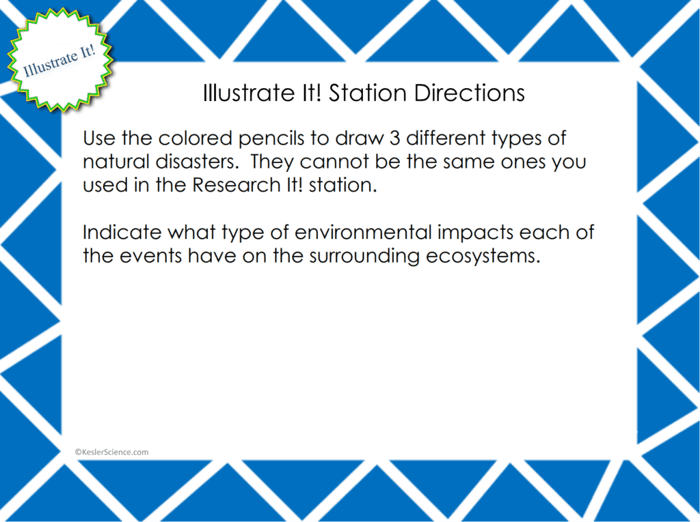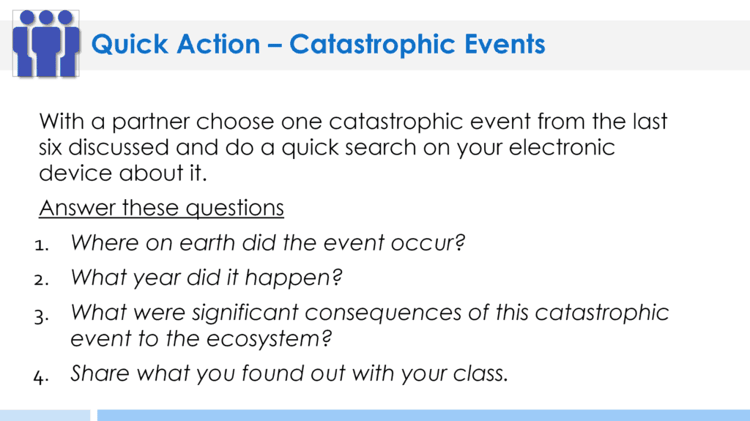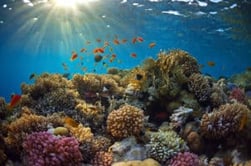The teacher will help to clear any misconceptions about catastrophic events. A major misconception is that students may think that all volcanoes produce lava or do not understand that a tsunami is actually produced by an earthquake under the ocean surface.
Estimated Class Time for the Engagement: 20-30 minutes
EXPLORATION
This student-centered station lab is set up so students can begin to explore catastrophic events. Four of the stations are considered input stations where students are learning new information about catastrophic events and four of the stations are output stations where students will be demonstrating their mastery of the input stations. Each of the stations is differentiated to challenge students using a different learning style. You can read more about how I set up the station labs here.
EXPLORE IT!
Students will be working in pairs to better understand catastrophic events. In this station, students try to identify the ecological destruction that catastrophic events cause. Students will follow the steps and record their observations on their lab sheet.
WATCH IT!
At this station, students will be watching a short video explaining catastrophic events. Students will then answer questions related to the video and record their answers on their lab station sheet. For example: List 4 natural disasters from the video. What are the impacts on the ecosystem after a volcano erupts? What are the impacts to an ecosystem after an earthquake has happened?
RESEARCH IT!
The research station will allow students to explore an interactive web page that helps them to understand many types of catastrophic events. Students will be instructed to complete a few tasks and record answers on their lab sheets.
READ IT!
This station will provide students with a one page reading about catastrophic events exclusively tornadoes and the Enhanced Fujita Scale. There are 4 follow-up questions that the students will answer to show reading comprehension of the subject.
ASSESS IT!
The assess it station is where students will go to prove mastery over the concepts they learned in the lab. The questions are set up in a standardized format with multiple choice answers. Some questions include: Which is not an impact on the ecosystem after a drought? Which of these is not an impact on the ecosystem after a hurricane? Which is the best synonym for catastrophic? Which is a long-term change?

WRITE IT!
Students who can answer open-ended questions about the lab truly understand the concepts that are being taught. At this station, the students will be answering three task cards: How does a hurricane impact the beach and surrounding ecosystem once it makes landfall? What type of impact would an EF5 tornado have on an ecosystem? How are birds impacted by the eruption of a volcano?
ILLUSTRATE IT!
Your visual students will love this station. Students are to draw pictures that demonstrate their knowledge of catastrophic events. Students will also indicate the environmental impacts these events have on the surrounding ecosystems.

ORGANIZE IT!
Students at this station will match the sets of cards. Cards are descriptions of events that students will have to identify as being either short-term or long-term environmental impacts due to catastrophic events. Once students have completed their organization, the teacher will check their understanding.
Estimated Class Time for the Exploration: 1-2, 45 minute class periods
EXPLANATION
The explanation activities will become much more engaging for the class once they have completed the exploration station lab. During the explanation piece, the teacher will be clearing up any misconceptions about catastrophic events with an interactive PowerPoint, anchor charts, and notes. The catastrophic events lesson includes a PowerPoint with activities scattered throughout to keep the students engaged.
The students will also be interacting with their journals while taking notes from the PowerPoint. If you have students that need modified notes, the 5E lessons come equipped to help give every student access to the lesson.
Estimated Class Time for the Exploration: 2-3, 45 minute class periods
ELABORATION
The elaboration section of the 5E method of instruction is intended to give students choice on how they can prove mastery of the concept. When students are given choice the ‘buy-in’ is much greater than when the teacher tells them the project they will have to create. The elaboration project will allow students to create a journal, pamphlet, newspaper article, news report, personal story or even a timeline.Estimated Class Time for the Elaboration: 2-3, 45 minute class periods (can also be used as an at-home project)
EVALUATION
The final piece of the 5E model is to evaluate student comprehension. Included in every 5E lesson is a homework assignment, assessment, and modified assessment. Research has shown that homework needs to be meaningful and applicable to real-world activities in order to be effective. When possible, I like to give open-ended assessments to truly gauge the student’s comprehension.
Estimated Class Time for the Elaboration: 1, 45 minute class period
DOWNLOAD THE FULL LESSON NOW
The full lesson is available for download from the Kesler Science Store. Save yourself a ton of time and grab it now.






